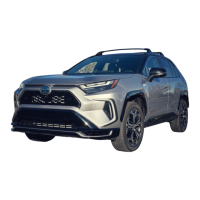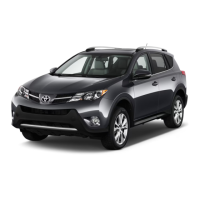134
2-2. Charging
speed for EV driving. (P.90)
● Leave a low level of charge in the
hybrid battery (traction battery) when
leaving the vehicle undriven for a long
period of time.
After confirming that EV mode or
AUTO EV/HV mode has switched to
HV mode, turn the power switch off.
● Use the charging schedule function as
much as possible in order to fully
charge the hybrid battery (traction bat-
tery) immediately before starting off.
(P.144)
Also, if the hybrid battery (traction bat-
tery) capacity reduces, the distance that
can be driven in EV mode or AUTO
EV/HV mode decreases. However, vehi-
cle performance does not significantly
become worse.
■ When the remaining charge of the
hybrid battery (traction battery) is
low after charging
In the following situations, the remaining
charge of the hybrid battery (traction
battery) after charging completes may
be less than normal in order to protect
the system (the EV driving range after
the battery is fully charged may be
shorter).
*
● Charging is carried out when the out-
side temperature is low or high.
● Charging is carried out immediately
after high-load driving or in extreme
heat.
When none of the above situations
apply and there is a drastic drop in the
remaining charge of the hybrid battery
(traction battery) after charging com-
pletes, have the vehicle inspected by
any authorized Toyota retailer or Toyota
authorized repairer, or any reliable
repairer.
*
: When this occurs, even if the remain-
ing charge display of the hybrid bat-
tery (traction battery) shows that it is
fully charged, the remaining charge
rapidly decreases faster than normal.
■ When the charging amount sent to
the hybrid battery (traction battery)
decreases
When the amount of power supplied by
the charger is low or operation of the
“Battery Heater”, etc., reduces the
charging power sent to the hybrid bat-
tery (traction battery), the charging
amount sent to the hybrid battery (trac-
tion battery) may decrease.
■ Charging time may increase
In the following situations, charging time
may become longer than normal:
● In very hot or very cold temperatures.
● When the hybrid battery (traction bat-
tery) becomes hot, such as immedi-
ately after high-load driving.
● The vehicle is consuming a lot of elec-
tricity, for example, when the head-
lights are on etc.
● When using “My Room Mode”.
(P.164)
● There is a power outage during
charging.
● There is an interruption in the electri-
cal supply.
● There is a drop in the voltage of exter-
nal power source.
● The charge in the 12-volt battery is
low, for example due to the vehicle
being left unused for a long period of
time.
● The maximum charging current is set
to 8A or 16A
*
. (P.125, 126)
● When the “Battery Heater” operates.
(P.128)
● When the “Battery Cooler” is operated
before charging. (P.128)
● When the plug generates heat due to
a loose socket connection etc.
*
: Vehicles with 7 kW onboard traction
battery charger only
■ Using a DC Charger
DC Chargers cannot be used with this
vehicle.

